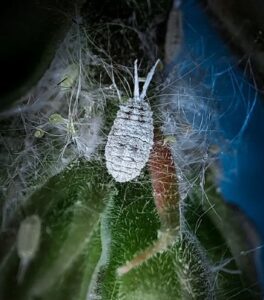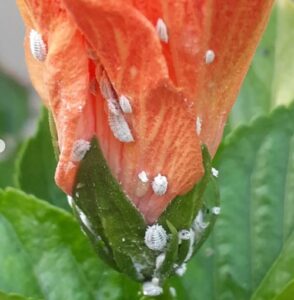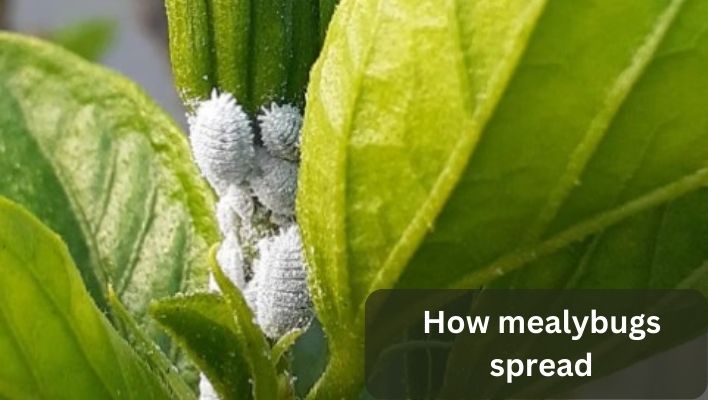Are you seeing tiny white bugs on your plants and unsure how they got there? Chances are, you’re dealing with mealybugs. These pests are notorious for their ability to quickly spread and take over a plant, leaving it weak and stunted. But how do these pesky pests spread so quickly?
Knowing how mealybugs spread and how to control them is essential for growing a healthy garden. These pests may enhance the spread of diseases, which could destroy a garden. For this reason, they need to be controlled as soon as possible.
But how do they manage to do this? In this blog post, we’re diving into the world of mealybugs and uncovering the ways they spread to help you protect your plants and keep them looking healthy.
How do mealybugs spread indoors
Mealybugs can spread in several ways, including through direct contact with infested plants, air currents, or the movement of infested soil or pots.
One common way that mealybugs can spread indoors is by infesting new plants that are brought into the house. Mealybugs can be hidden in the folds of leaves or the soil of a plant, and if these infested plants are brought into a home, the mealybugs can quickly spread to nearby plants by crawling.
Another way that mealybugs can spread indoors is through air currents. Mealybugs can fly short distances and can also be carried by wind or air currents, which can help them spread from one plant to another.
Mealybugs can spread indoors through various means, such as:
- By crawling or flying: Mealybugs can crawl or fly to nearby plants or areas, spreading to different parts of the indoor environment.
- Transporting infested plants: If you bring home an infested plant, it can introduce mealybugs to your indoor environment.
- Movement through walls and floors: Mealybugs can move through small cracks and crevices in walls and floors, spreading to other rooms in your home.
- Transport on clothing: Mealybugs can also spread by clinging to clothing or other materials that have come into contact with infested plants. When those items are moved, they can then be transferred to other parts of the house.
- Reproduction: Once inside, mealybugs will reproduce and can quickly colonize a space. They can even migrate to other rooms in the house through small openings and cracks.
- Through animals: Mealybugs can spread through animals such as birds, pets, ants, and other insects, which can transfer them from one area to another.
- Airborne: Mealybugs can also travel through the air via dust or other small particles, potentially spreading to other home parts.
Overall, mealybugs can spread quickly and easily in a garden or greenhouse setting if not properly controlled. In outdoor environments, mealybugs can spread through the movement of infested plants or insects, such as ants, which can transport mealybugs from one plant to another.

How far can mealybugs travel
Mealybugs are slow-moving pests and typically do not travel far on their own. However, they can be transported over long distances by humans, either intentionally (e.g., through the movement of infested plants) or unintentionally (e.g., on clothing or in luggage).
Additionally, mealybugs can be transported by other insects, such as ants, which can carry them to new areas. They can also be spread by wind, pets, birds, and other insects that may transport them to new locations. Overall, mealybugs can travel several feet independently, but they can be transported much further through human activities.
There is a variety called Long-tailed Mealybug (Pseudococcus longispinus), which is known to fly, but most other species rely on other means of transportation.
By crawling, mealybugs can also spread between plants in a greenhouse or indoor setting. If you have an infestation in your houseplants, you should isolate the affected plant and inspect all other plants to see if they have become infested.
Where do mealybugs come from
How do mealybugs get to my plants? Mealybugs are commonly found in warm and humid environments, such as greenhouses and indoor gardens. They can also be found in outdoor gardens and landscapes in tropical and subtropical regions. They can be introduced to plants through various means, including:
- Infested plants: Mealybugs can be brought into a garden or greenhouse on infested plants that are purchased or traded.
- Natural migration: Mealybugs can migrate to plants from nearby infested areas.
- Outdoor to indoor: Mealybugs can also be brought indoors on clothing, shoes, or other items from outdoor gardens or landscapes.
- Through other insects: Mealybugs can also be brought to plants by other insects, such as ants, which may carry the mealybugs to plants in search of food or shelter.
- Through the air: Mealybugs are small and lightweight, which allows them to be easily carried by wind currents. They can also be carried on the wings of insects such as ants.
- By hitching a ride on birds or other animals.,
- Through humans: People in contact with infested plants can unknowingly bring mealybugs to other plants on their clothing or tools.
Once mealybugs have made it to a new plant, they can reproduce quickly and establish colonies. If left unchecked, mealybugs can cause significant damage to plants by sapping their sap and transmitting diseases.
Mealybug damage on plants
Mealybugs are small, sap-sucking insects that can cause significant damage to plants. They are often covered in a white, waxy coating that gives them a mealy appearance, hence their name. Mealybugs are most commonly found on indoor plants but can also infest outdoor plants.
Mealybugs feed on the sap of plants, which can cause leaf yellowing, wilting, and even plant death if left untreated. They can also produce a sticky, sweet-smelling substance called honeydew, which can attract ants and promote the growth of sooty mold.
They are typically found on plants’ leaves, stems, and fruit and feed by piercing the plant tissue and extracting sap. Symptoms of mealybug damage include:
- Yellow or brown spotting on leaves
- Leaf curling or distortion
- Sticky honeydew excretion on leaves, which can lead to sooty mold growth
- Reduced growth and vigor in the plant
- Wilting and death of leaves or branches
- Reduced fruit production
If left unchecked, mealybug infestations can weaken or kill plants. It is also important to keep the plants healthy by providing them with adequate water and nutrients to prevent infestation.

Mealybug control home remedy
There are numerous homemade insecticides to get rid of mealybugs from your plants. However, using one or two combinations of these methods is important for better effectiveness.
- Soap and water: Mix 1 quartz of water with two tablespoons of liquid dish soap in a spray bottle and apply it directly on the mealybugs. Repeat the process once a week until the infestation is gone.
- Neem oil: Mix 1 tablespoon of neem oil with one cup of water in a spray bottle and apply it on the mealybugs. This will suffocate them and also prevent them from laying eggs.
- Alcohol spray: Mix two caps of alcohol with one cup of water in a spray bottle and spray directly on the mealybugs. This will dehydrate and kill them.
- Diatomaceous earth: Sprinkle diatomaceous earth on the affected plants, making sure to get it on the mealybugs. This will dehydrate and kill them. You can also mix DE with water and spray your plants to kill these pests.
- Garlic and pepper spray: Blend garlic and pepper in a blender and mix with water in a spray bottle. Apply this spray on the affected plants, and it will deter the mealybugs from feeding on the plants.
- Use rubbing alcohol: Mix equal parts of rubbing alcohol and water in a spray bottle and spray the affected plants. The alcohol will dehydrate the mealybugs and kill them.
- Ladybugs: Ladybugs are natural predators of mealybugs and can help control infestations. You can purchase ladybugs from a gardening store and release them onto your plants.
- Use horticultural oil: Horticultural oil is a heavy oil that can smother and suffocate mealybugs. Mix a few drops of horticultural oil with water in a spray bottle and spray the affected plants.
- Remove and dispose of affected plants: If a plant is heavily infested with mealybugs, it may be best to remove and dispose of it to prevent the spread of the insects to other plants.
It’s important to note that these remedies are for light to medium infestations. These remedies work best as a preventative measure in the early stages of an infestation. If the infestation is severe, it’s best to consult a professional pest control service.
Heavy infestations require stronger measures like chemical pesticides, so you may want to call a professional. And always be careful when handling any chemicals or pesticides, always following the label instructions.
It is also important to note that some of these remedies may not be safe for all plants, so it’s always a good idea to check the plant’s care instructions before applying any treatment.
Prevention Notice
To prevent mealybugs from spreading indoors, it is important to regularly inspect your plants for signs of infestation, such as white, cottony masses on leaves or stems, and to quickly address any infestations that you find.
Also, avoid bringing new plants indoors unless you are confident they are not infested. In addition, good sanitation practices, such as regularly cleaning and disinfecting surfaces, can help to keep mealybugs and other pests under control.
It’s also important to note that if you cannot control the pest or the infestation is heavy, you should consider seeking professional help. Some pesticide sprays may be effective on mealybugs, but it’s always best to check the label and follow the instructions carefully.
Conclusion
Mealybugs are a common pest that can spread easily in gardens and indoor plants. They are known to spread in various ways, including through the movement of infested plants, the transfer of adult females to new plants via insects or other means, and the spread of their eggs and nymphs through the movement of soil, equipment, and other materials.
To prevent the spread of mealybugs, it is important to keep an eye out for signs of infestation and take steps to control them early. This may include using pesticides, removing infested plants, and keeping plants well-maintained to prevent the spread of mealybugs.
However, the presence of natural predators and parasites, such as ladybugs and parasitic wasps, can help control mealybug populations and prevent further spread.
Therefore, it is important to take preventative measures, such as regularly inspecting plants for signs of infestation and promptly addressing any identified issues, to manage and control mealybug populations effectively.
